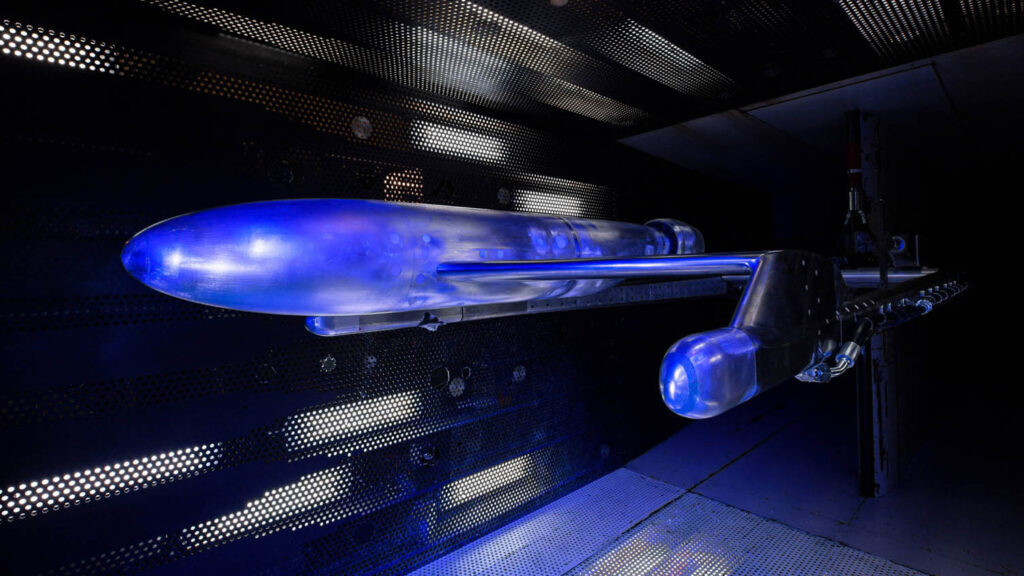Cradle-to-gate costs make all the difference in aerospace contract profitability. As more companies look to increase the efficiency of their medium to large-scale components, Wire Arc Additive Manufacturing (WAAM) places a different option on the table
The Aircraft Research Association (ARA) is accustomed to pushing the design envelope for technical advantage, and wanted to achieve the benefits of metals 3D printing for prototyping, the dimensional accuracy of traditional machining, along with greater speed and lower costs.
Having previously investigated the potential production of a steel plane wing with the founders of WAAM3D, ARA’s team of aerospace specialists based in Cranfield, UK, already knew that WAAM had the expertise required to help reduce wind tunnel model lead times and costs.
To test the theory, ARA selected a 190mm diameter and 350mm length aluminium nose cone to be produced using the WAAM process, which could then be integrated in a wind tunnel model and scrutinised in its transonic wind tunnel.
Working closely with ARA, the WAAM3D team considered the geometry and made sure that the majority of the starting aluminium 2319 feedstock was built up around a vibration damper integrated within the nose cone. This minimised deposited material, saving time, money and materials. The near-net shape was produced in RoboWAAM, WAAM3D’s large-format 3D metal additive printing platform, with careful monitoring conducted throughout the deposition process.
As ARA principal aerodynamics engineer Dr James Alderman explains: “We wanted a low-risk way to investigate the WAAM technique. A nose cone is a relatively unstressed part, with a safety factor of around 200. The aim was to see how the process performed in terms of timings, cost and material savings and to subsequently decide if higher-stress components might also benefit from this production process.”
Less waste, more speed
WAAM is an environmentally sympathetic manufacturing process that helps to resolve many macro and micro aerospace engineering issues, explains WAAM3D CEO Dr Filomeno Martina.
For example, when it comes to reducing manufacturing waste, the buy-to-fly (BTF) ratio for aero engine components can be as high as 25. By using WAAM, the BTF is reduced to <2.
Also, WAAM can deliver cost savings of up to 70%, compared to machining from solid. An example 3D-printed outboard landing gear made from titanium (Ti-6Al-4V) achieved 70% cost savings.
A printed satellite propellant tank for space exploration delivered 50% cost savings. When designing prototype parts for testing, lead times can cause significant issues. Martina says that WAAM can reduce the time for a large, forged component from one year to a matter of weeks. When the satellite propellant tank was printed, for example, WAAM3D was able to achieve a 65% reduction in the overall lead time compared to a forged equivalent. Alongside lead time issues, saving raw materials can have an impact on a component’s final cost.
The ARA aluminium nose cone project saw material usage reduced by 74% over traditional machining.
“Once printed, the critical surfaces of the nose cone – those that would be windswept or interfacing – underwent post-machining and inspection at ARA,” says Alderman.
“We set surface profile and finish tolerances of < +- 0.1mm and Ra < 0.8 microns respectively, and these were achieved with ease. Importantly, there were no issues with any distortion during the machining process.”
As well as reducing material waste, ARA believes that WAAM would deliver around 5% to 10% cost savings compared to machining from aluminium billet. And with the learning curve of the project applied, the team would be able to deliver the finished item faster, and apply itself to other medium to large aircraft components, such as cruciform, flanges, stiffened panels and wing ribs.
As more companies begin to explore ways to improve the manufacturing efficiency of their medium to largescale engineering components, it would be no surprise to see WAAM taking off in aerospace design.
This article first appeared in DEVELOP3D Magazine
DEVELOP3D is a publication dedicated to product design + development, from concept to manufacture and the technologies behind it all.
To receive the physical publication or digital issue free, as well as exclusive news and offers, subscribe to DEVELOP3D Magazine here






